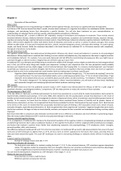Zusammenfassung
Summary cognitive behavior therapy (book Beck third ed)
- Kurs
- Hochschule
- Book
This is a summary for the course CBT at UU (master clinical psychology). The summary is written in English. IMPORTANT: you still need the book if you use this summary. The book contains lots of example conversations with patients and figures of the forms used in CBT. In the summary i have referenc...
[ Mehr anzeigen ]




